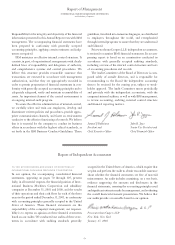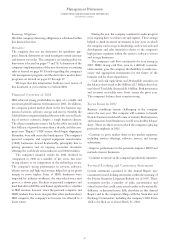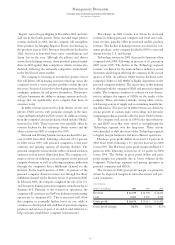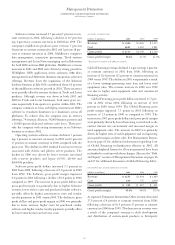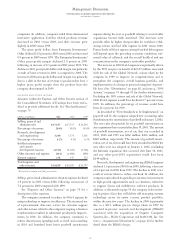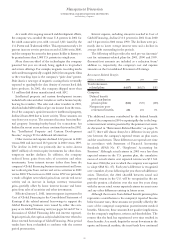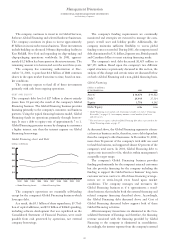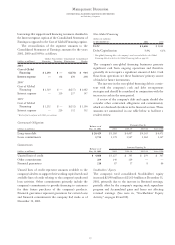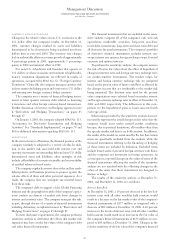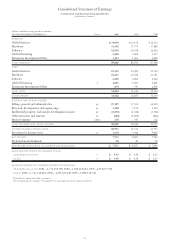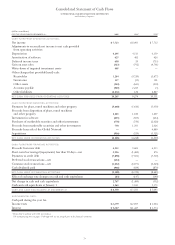IBM 2001 Annual Report Download - page 66
Download and view the complete annual report
Please find page 66 of the 2001 IBM annual report below. You can navigate through the pages in the report by either clicking on the pages listed below, or by using the keyword search tool below to find specific information within the annual report.
decreased 34.4 percent (33 percent at constant currency) to
$1.6 billion compared with the fourth quarter of 2000.
Revenue from Global Services, including maintenance,
declined 1.4 percent (up 1 percent at constant currency) in
the fourth quarter to $9.1 billion. Global Services revenue,
excluding maintenance, declined 1.6 percent (up 1 percent at
constant currency). The company’s annuity-like outsourcing
and maintenance businesses continued to perform well, but
the company felt the economic pressure in Consulting
Services and BIS during the quarter. In addition, a slowdown
in contract signings in the middle of the year, particularly in
short-term engagements, affected the company’s fourth
quarter revenue. New contract signings for Global Services
in the fourth quarter were approximately $15 billion.
Hardware revenue decreased 24.0 percent (21 percent at
constant currency) to $8.7 billion from the 2000 fourth quar-
ter. Mainframe computing capacity, however, grew 12 percent
in the fourth quarter, as measured in MIPS. Revenue from
the company’s UNIX-based pSeries declined, in large part
because of transition to the company’s new “Regatta” family
of UNIX servers, which began shipping on December 14,
2001. Personal computer and microelectronics revenue
decreased substantially over the prior year’s quarter, princi-
pally due to price pressures in personal computers and an
ongoing downturn affecting the worldwide semiconductor
and OEM markets. Revenue from the company’s high-end
storage product “Shark” grew in a declining market.
Software revenue increased 6.0 percent (8 percent at con-
stant currency) to $3.8 billion compared to the prior year’s
fourth quarter. Overall, the company’s middleware software
revenue grew 9 percent (10 percent at constant currency).
The company’s data management and WebSphere products
had strong growth versus the fourth quarter of 2000.
Although fourth-quarter revenue declined year to year in the
company’s Tivoli and Lotus businesses, both units had
strong revenue growth sequentially. Tivoli and Lotus are
benefiting from operational efficiencies gained as a result of
integrating their business processes into the company’s
Software business, which has improved profitability in both
units. Operating system revenue declined 4 percent (2 per-
cent at constant currency).
Global Financing revenue decreased 4.6 percent (4 percent
at constant currency) in the fourth quarter to $927 million
primarily due to a lower earnings-generating asset base and
lower sales of used equipment. As expected, revenue from
the Enterprise Investments/Other area, which includes
custom-made products to third-party companies, declined
20.0 percent (18 percent at constant currency) compared to
the fourth quarter of 2000 to $340 million. The company
has been consistently shifting development and distribution
of products in this segment to third-party companies.
The company’s total gross profit margin improved to
38.3 percent in the 2001 fourth quarter from 37.3 percent in
the 2000 fourth quarter. Gross margins improved in each
revenue segment except for Hardware, which declined by
4.1 points, due to low volumes in the Technology segment
and pricing pressures in personal computers and HDDs.
Despite absorbing workforce-balancing actions and
write-downs of certain equity investments, the company’s
Total Expense and Other Income improved 5.6 percent to
$5.4 billion. The improvement came from each of the com-
pany’s two main expense categories: SG&A expense as well as
research and development expense. The company continued
to reduce its expense and improve operating efficiencies
through the use of electronic procurement, sales, education
and customer support systems. These systems, known
as e-procurement, ibm.com, e-learning and e-Care, have
resulted in substantial productivity improvements. The
company’s fourth quarter 2001 Intellectual property and
custom development income, which includes the transfer of
the company’s optical transceiver intellectual property, was
essentially flat compared to such income in 2000.
The company’s tax rate in the fourth quarter was 29.3 per-
cent compared with 29.5 percent in the fourth quarter of 2000.
The company spent approximately $1.0 billion on common
share repurchases in the fourth quarter. The average number
of common shares outstanding assuming dilution was lower
by 32.6 million shares in fourth quarter of 2001 versus the
fourth quarter of 2000, primarily as a result of the ongoing
common share repurchase program. The average number of
shares assuming dilution was 1,758.0 million in fourth quarter
2001 versus 1,790.6 million in fourth quarter 2000.
Financial Condition
During 2001, the company continued to demonstrate strong
financial performance, enabling it to make appropriate
investments to support future growth and increase share-
holder value. The company spent $5,844 million for research,
development and engineering, including software develop-
ment that was capitalized on the Consolidated Statement of
Financial Position, $4,483 million for plant and other prop-
erty, including machines used in strategic outsourcing
contracts; $1,177 million for machines on operating leases
with customers; and $5,293 million for the repurchase of the
company’s common shares. In addition, the company paid
cash totaling approximately $916 million of the aggregate
$1,082 million purchase price of the company’s two acquisi-
tions in 2001. The company had $6,393 million in Cash and
cash equivalents and current Marketable securities at
December 31, 2001. The company’s debt levels declined
$1,425 million in 2001 primarily due to a decline in Global
Management Discussion
INTERNATIONAL BUSINESS MACHINES CORPORATION
and Subsidiary Companies
64


